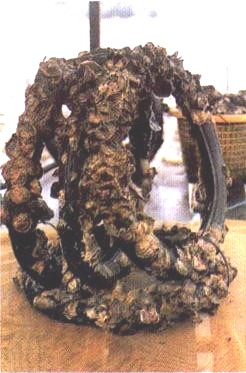|
Hatchery Production
of Spat
The technology for the mass production of both attached and free seed of C.
madrasensis has been developed by CMFRI at its Shellfish Hatchery, Tuticorin.
The criteria to be followed for site selection and the inputs required for the establishment
of the edible oyster hatchery are the same as those of other bivalve hatcheries.
Hatchery operation
A) Brood stock: In
the selection of brood stock, the area of occurrence of the oysters, their condition
and age are considered. It is desirable to have a mixed stock, coming from several
areas. The salinity and temperature at the collection site are recorded, and if
required the oysters are slowly acclimatized to the hatchery conditions. Oysters
in the length range 60-90 mm; with 30% of them (males) in 60-75 mm length range
ensures the desired representation of the two sexes in the brood stock.
The oysters are cleaned thoroughly with a wire brush to remove the plants and animals
adhering to the shell. A batch of 25 oysters is placed on a synthetic twine-knit
PVC frame in 100 l FRP tank, and raw (unfiltered) pre-cooled seawater (at 20-22°C)
is filled in the tank and aerated. About 2-3 litres of mixed algal culture, (1.5
to 2 million cells/ml) pre-cooled at 20-22°C is given as feed to the oysters
twice a day. Thus the oysters are conditioned by holding them in the conditioning
room at about 10°C below the ambient temperature.
B) Spawning: The conditioned
oysters are subjected to thermal stimulation by suddenly transferring them to seawater
with a temperature of 34 to 35°C. This sudden change in the temperature induces
spawning. The spawning oysters are immediately separated and placed in spawning
trays having filtered seawater at the ambient temperature. After the completion
of spawning the oysters are removed.
C) Fertilization and developmental stages:
The gametes are mixed and gentle aeration provided. Fertilization takes place
immediately and the first cleavage within 45 min. At the end of 4 hrs morula stage
is reached and the swimming morula are siphoned and reared in filtered seawater.
At the end of 20 hrs the straight-hinge or D-shaped larval stage is reached.
The various larval stages, their size and
duration
|
Stage
|
Size mm
|
Hours/days
|
|
Straight hinge
|
60-70
|
20 hrs
|
|
Early umbo
|
100
|
3rd day
|
|
Mid umbo
|
150
|
7th day
|
|
Advanced umbo
|
260-270
|
12th to 15th day
|
|
Eyed larva
|
280-290
|
13th and 17th day
|
|
Pediveliger
|
330-350
|
14th to 18th day
|
D) Larval rearing:
As the larvae grow, their density in the rearing tanks is reduced and food ration
increased. The schedule for the rearing density and food requirements of larvae
is given below.
|
Larval stages
|
Density of larvae/ml
|
Algal cell concentration in ml/ larval/ day
|
|
Straight hinge
|
5
|
3000-4000
|
|
Umbo
|
3
|
4000-5000
|
|
Advanced umbo to eyed stage
|
2
|
5000-8000
|
|
Pediveliger
|
2
|
10000-12000
|
E) Spat settlement and rearing:
Non-toxic, hard, chemically stable and clean spat collectors are used to produce
attached spat. The shell is brushed well, washed in chlorinated water followed by
soaking and repeated washing in seawater, so that the pH of the water in the rearing
tanks is maintained.
The shell collectors are spread uniformly on the bottom of one tonne FRP tanks containing
filtered seawater. The eyed oyster larvae are released in the tanks at a concentration
of 1 larva/ml; the seawater is well aerated. In the following few days the larvae
are set as spat on the oyster shells. The concave side of the shell usually has
more settlement.
For the production of cultchless spat (also called free spat or single spat), pre-treated
polythene sheet is spread as a lining on the bottom and sides of a FRP tank. Oyster
shell grit of 0.5 mm size are washed thoroughly, sterilized in 10-ppm chlorine,
further washed in running filtered seawater and dried. These shell grits are spread
uniformly at the bottom of the tank and the larvae are released at the setting stage.
The spat are reared for about 3 weeks after setting in the hatchery before they
are transferred to the field for nursery rearing.

Spat collecting tyre clutch
Top
|